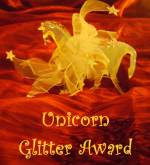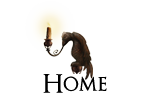Scribble City Central's thirty-first Fantabulous Fridays A-Z comes from Sally Prue. I read Sally's first book Cold Tom (which won the Branford Boase) some years ago, and remember being very impressed by the seemingly effortless way she drew me into Tom's story, (and also delighted to find a new take on one of my favourite of all the British folk tales, Thomas the Rhymer). The Guardian called it
"One of those rare, strange, wonderful books that makes you see the world through different eyes"and I'd certainly agree with that.
March of the Owlmen, the second in the wonderful Truth Sayer series is different, but equally entrancing, as is Plague of Mondays, the third and final book. I find it serendipitous that Sally's hero in these stories has the same name - Nian - as the scary Chinese creature which appeared here last week, courtesy of Saviour Pirotta!
The last time I read a series as good as this one was when I discovered (a little later in life than I would have liked) Diana Wynne Jones's Chrestomanci books. Nian reminds me a little of Christopher Chant in The Lives of Christopher Chant. He has that same air of endearingly puzzled confusion when he travels between the worlds, but he's very much his own thoughtful and determined boyish self. The red-robed Tarhun are a work of comic genius (I never want to eat anything from the revolting Snerk's kitchen), and Sally is also a mistress of the art of inventing boggingly funny (and appropriate) swearwords - a rare skill in a children's writer. Truly, I could go on and on about the excellence of these books for a very long time - they should most certainly be much more widely known, and bought for every reading child's bookshelf.
Sally's piece is rather different to the others in this series, in that she's writing about her own creation, rather than a beast or being from an established mythology. I have a theory that once a new creature springs into life in a writer's head (rather like Athena springing fully formed from the head of Zeus), it is in the world to stay, and takes on a life of its own. Who knows where the sharp black lines of Owlmen will pop up next (oh Lord - please not on my bedroom wall!)? I've found it fascinating to read about how these terrifying creatures came to be - and I hope you will too. Here's Sally to tell you all about them!
O for Owlmen
A Slice of Death
SP: What’s the scariest sort of monster?
One that’s big? Ravening? Vicious?
Or is it one that watches from the dark, one you can’t see properly, one that only moves when you’ve got your back to it?
I discovered the owlmen by accident, and I’m afraid they are going to be with me forever. That’s how it is, sometimes, with books.
And I’d started off so innocently. So happily.
But the owlmen creep up on you when you’re looking the other way.
****
The thing was, I’d written a book called The Truth Sayer, which is about an alien boy who arrives in our world only to find that his presence here is making the universe tear itself to pieces.
I ended up with a lot of respect for this boy, who’s called Nian (you say it NEE’n) and I was pleased to be offered the chance to relate some more of his adventures.
Unfortunately, I discovered that the being-in-the-wrong-world-causing-everything-to-disintegrate thing caused all sorts of problems. I wanted to write about huge terrifying monsters invading Nian’s world, but this couldn’t happen without the whole universe breaking up into inconveniently small pieces.
What could I do?
Well, I had a bit of wriggle-room because Nian can eat while he’s in a foreign world, so there was nothing stopping me having invading monsters as long as they weren’t any bigger in total than a few fishfingers and the odd packet of crisps.
So. Small monsters...
Attack of the killer gerbils?
Hmmmm...
Now, Nian’s home is an empty castle-type thing. In fact it’s so empty that I began to wonder about having the monsters drawn on the walls. That way they could be big and yet have very little substance.
Yes, they could be made of something a bit like paper.
Attack of the killer anaglypta?
Hmmmm...
Though, come to think about it, paper can give you a jolly nasty cut. Perhaps the monsters could have sharp edges...
I was doing a lot of staring into space at this point, but of course the trouble with space is that the stuff’s transparent, and you can’t help but see the things on the other side of it.
Now, there’s a bit of pattern on a rug in our house which looks exactly like Anubis the jackal-headed god of ancient Egypt.
(It looks, as it happens, like Anubis swinging on a trapeze, but the trapeze is neither here nor there.)
Anubis was just the sort of terrifying creature for which I’d been searching. Yes: I could give my monster the head of an animals.
Perhaps I could have a Hamster House of Horror.
Hmmmm...
No, it needed to be something dark, something deadly. Something that could stare out of the darkness with sharp focused eyes...
...brrr!
And as I searched for enlightenment the goddess of wisdom came to my aid. She was not Egyptian, as it happened, but Greek, and she was Athena, whose emblem is an owl.
An owl. A creature with the head of an owl. That was what I needed. Yes.
And that was the beginning of the owlmen. But it was only the beginning, because of course the owlmen developed during the writing of the book. For instance, I didn’t realise at first that each tall owl-headed image that appeared on the white walls of Nian’s home consisted of many owlmen stacked one on top of the other. I didn’t realise why sometimes one owlman would step away from the wall and stalk through the place, cutting through everything in its path in a frenzy of destruction.
I didn’t realise to whom the mind behind these dreadful creatures belonged, or what she wanted.
Most terrifyingly of all, though I could feel the cold aggression of the owlmen’s eyes staring at me through the darkness, I hadn’t a clue how to stop them.
The working title for the book was A Slice of Death, but later it became March of the Owlmen.
For march they do.
...there were so many, so very many. The owlmen’s eyes were invisible, but the malice of their gaze was tangible, threatening, as if needles were stabbing out of the darkness...
The fireball thumped into an owlman and might have killed it, but...there were more owlmen behind, more and more and more...
How could anyone stop them?
Look, just watch out, all right?
And don’t say I didn’t warn you....
SCC: Thank you, Sally. What a great example of how a writer's mind goes through the creative process. I'm sure many of my Lovely Readers will learn a lot from this.
Want to read March of the Owlmen? You can buy it HERE.
Next Week: Celia Rees, author of The Fool's Girl, takes on P for Puck. Be prepared for mischievous midnight doings!





























.JPG)








